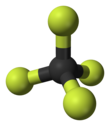| |||

| |||
| Names | |||
|---|---|---|---|
| IUPAC names
Tetrafluoromethane
Carbon tetrafluoride | |||
| Other names
Carbon tetrafluoride, Perfluoromethane, Tetrafluorocarbon, Freon 14, Halon 14, Arcton 0, CFC 14, PFC 14, R 14, UN 1982
| |||
| Identifiers | |||
3D model (JSmol)
|
|||
| ChEBI | |||
| ChemSpider | |||
| ECHA InfoCard | 100.000.815 | ||
| EC Number |
| ||
PubChem CID
|
|||
| RTECS number |
| ||
| UNII | |||
CompTox Dashboard (EPA)
|
|||
| |||
| |||
| Properties | |||
| CF4 | |||
| Molar mass | 88.0043 g/mol | ||
| Appearance | Colorless gas | ||
| Odor | odorless | ||
| Density | 3.72 g/L, gas (15 °C) | ||
| Melting point | −183.6 °C (−298.5 °F; 89.5 K) | ||
| Boiling point | −127.8 °C (−198.0 °F; 145.3 K) | ||
| Critical point (T, P) | −45.55 °C (−50.0 °F; 227.6 K), 36.91 standard atmospheres (3,739.9 kPa; 542.4 psi)[1] | ||
| 0.005%V at 20 °C 0.0038%V at 25 °C | |||
| Solubility | soluble in benzene, chloroform | ||
| Vapor pressure | 106.5 kPa at −127 °C | ||
Henry's law
constant (kH) |
5.15 atm-cu m/mole | ||
Refractive index (nD)
|
1.0004823[2] | ||
| Viscosity | 17.32 μPa·s[3] | ||
| Structure | |||
| Tetragonal | |||
| Tetrahedral | |||
| 0 D | |||
| Hazards | |||
| Occupational safety and health (OHS/OSH): | |||
Main hazards
|
Simple asphyxiant and greenhouse gas | ||
| NFPA 704 (fire diamond) | |||
| Flash point | Non-flammable | ||
| Safety data sheet (SDS) | ICSC 0575 | ||
| Related compounds | |||
Other anions
|
Tetrachloromethane Tetrabromomethane Tetraiodomethane | ||
Other cations
|
Silicon tetrafluoride Germanium tetrafluoride Tin tetrafluoride Lead tetrafluoride | ||
Related fluoromethanes
|
Fluoromethane Difluoromethane Fluoroform | ||
Except where otherwise noted, data are given for materials in their standard state (at 25 °C [77 °F], 100 kPa).
| |||
Tetrafluoromethane, also known as carbon tetrafluoride or R-14, is the simplest perfluorocarbon (CF4). As its IUPAC name indicates, tetrafluoromethane is the perfluorinated counterpart to the hydrocarbon methane. It can also be classified as a haloalkane or halomethane. Tetrafluoromethane is a useful refrigerant but also a potent greenhouse gas.[4] It has a very high bond strength due to the nature of the carbon–fluorine bond.
- ^ Lide, David R.; Kehiaian, Henry V. (1994). CRC Handbook of Thermophysical and Themochemical Data (PDF). CRC Press. p. 31.
- ^ Abjean, R.; A. Bideau-Mehu; Y. Guern (15 July 1990). "Refractive index of carbon tetrafluoride (CF4) in the 300-140 nm wavelength range". Nuclear Instruments and Methods in Physics Research Section A: Accelerators, Spectrometers, Detectors and Associated Equipment. 292 (3): 593–594. Bibcode:1990NIMPA.292..593A. doi:10.1016/0168-9002(90)90178-9.
- ^ Kestin, J.; Ro, S.T.; Wakeham, W.A. (1971). "Reference values of the viscosity of twelve gases at 25°C". Transactions of the Faraday Society. 67: 2308–2313. doi:10.1039/TF9716702308.
- ^ Cite error: The named reference
Ullwas invoked but never defined (see the help page).


